Ministry of Education
India’s Higher Education from Tradition to Transformation
प्रविष्टि तिथि:
13 FEB 2025 5:12PM by PIB Delhi
“Our commitment to quality education is yielding encouraging results. We will continue to support our educational institutions and provide opportunities for growth and innovation. This will help our youth greatly.”
~ Prime Minister Shri Narendra Modi
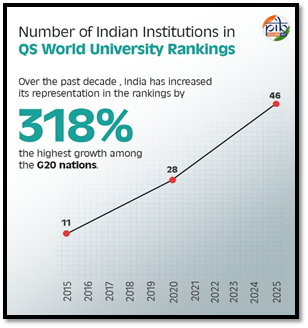
Education in India is deeply embedded in its ancient philosophical tradition, where Vidya was seen not merely as the accumulation of knowledge but as the means for holistic self-empowerment. In the ancient Indian texts, it is said that “The wealth of knowledge is indeed the supreme among all forms of wealth.” Over the years, India has strived to nurture and pass on this invaluable wealth of knowledge to its youth. Notably, in the last decade, India has seen an impressive 318% increase in its representation in global rankings—the highest growth among the G20 nations. Highlighting the positive leap in Higher Education.
India’s Universities Expansion and Student Flow
On 10th February, NITI Aayog released the report ‘Expanding Quality Higher Education through States and State Public Universities’. This report focuses on State Public Universities (SPUs), which have been key in making education more accessible, especially in remote areas. Currently, SPUs serve over 3.25 crore students. With the National Education Policy (NEP) 2020 aiming to double enrollment by 2035, SPUs will continue to educate the majority of students.
Evolution and Expansion of Country’s Education System
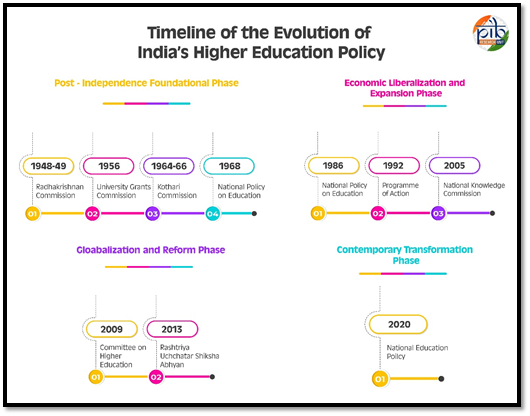
At the time of India’s independence in 1947, the country’s education system was fraught with challenges. India had only 17 universities and 636 colleges serving about 2.38 lakh students. The literacy rate was alarmingly low at 14%. Now, we have 495 State Public Universities and their more than 46,000 affiliated institutions that truly play a crucial role. These universities account for 81% of total student enrollment, making higher education accessible across India.
Rise of India's Higher Education Ecosystem
Since the establishment of the earliest universities in Calcutta, Bombay and Madras in 1857, India’s higher education ecosystem has expanded significantly. In 1950-51, the country had just 30 universities and 578 colleges. However, according to the AISHE Report 2021-2022, the landscape has transformed, with 1,168 universities, 45,473 colleges and 12,002 stand-alone institutions now in existence. Over the last two decades the number of colleges alone has more
than quadrupled, highlighting a remarkable growth in the sector.
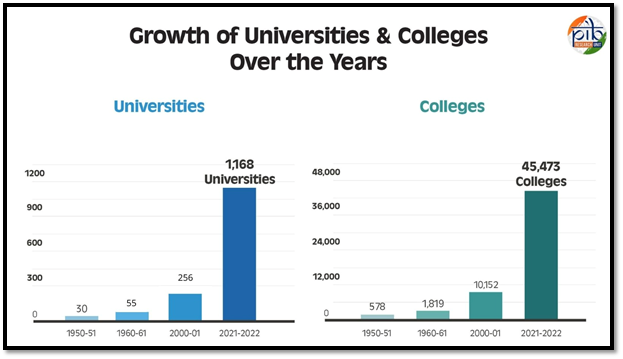
Significant Growth in GER
Between 1950-51 and 2021-22, India's Gross Enrollment Ratio (GER) grew by a remarkable 71 times showcasing significant progress in increasing student enrollments over the decades. The GER figures reflect this growth, with 0.4 in 1950-51 and reaching 28.4 in 2021-22. This impressive progress aligns with the goals set by the National Education Policy (NEP) 2020, which aims to achieve a GER of 50% by 2035.
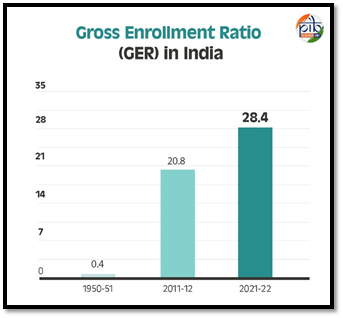
Have a look to enrollment trends across categories:
- State Public Universities (SPUs) enrollment: Increased from 2.34 crore students in 2011-12 to 3.24 crore students in 2021-22.
- Enrollment of Students from SEDGs (Socially and Economically Disadvantaged Groups) (2011-2022): Enrollment among OBCs increased by 80.9%, SC enrollment grew by 76.3%. In 2011-12, 15% of the eligible SC students (aged 18-23 years) were enrolled in HEIs across India which increased to nearly 26% by 2021-22. ST enrolment also doubled, rising by 106.8%, with the percentage of eligible ST students in higher education increasing from 11 to 21% over the decade, while Muslim minority enrollment increased by 60.6% and other minority enrollment rose by 53.2%.
- PwD Enrollment in SPUs: Increased from 52,894 students in 2011-12 to 53,921 students in 2016-17 (2% growth) and further to 56,379 students in 2021-22 (4.6% growth from 2016-17 and 6.6% growth from 2011-12).
- State Public Universities (Teaching departments and Constituent Units/Off-campus Centres) maintain the largest share of enrolments, growing from 24.5 lakhs in 2011-12 to nearly 29.8 lakhs in 2021 22, marking a decadal increase of 21.8%.
- State Private Universities (Teaching departments and Constituent Units/ Off-campus Centres) experienced the most significant growth, with enrolments soaring from 2.7 lakhs in 2011-12 to 16.2 lakhs in 2021-22 — an astonishing 497% increase.
- Central Universities (Teaching departments and Constituent Units/Off-campus Centres) saw a moderate growth of 26.4% over the decade, rising from 5.55 lakhs in 2011-12 to 7.01 lakhs in 2021-22.
The national GPI (Gender Parity Index) for 2021-22 was 1.01 compared to 0.87 in 2011-12, indicating a 16% increase towards gender equality over a decade.
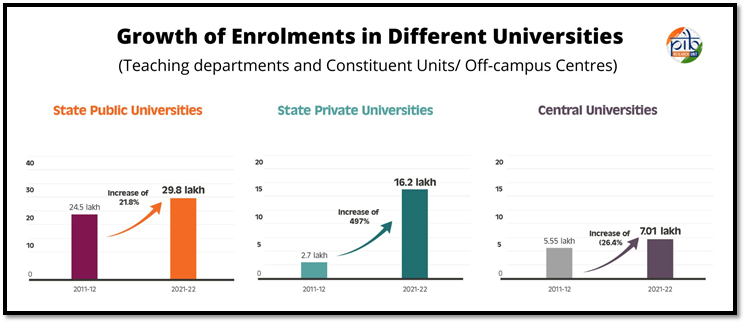
Teachers Across Academic Positions at All-India Level
India has approximately 16 lakh teachers in HEIs, with the majority (68%) being Lecturers/Assistant Professors. Readers/Associate Professors represent around 10% of the total faculty, followed by Professors & equivalent at 9.5%, Demonstrators/Tutors at 6%, Temporary Teachers at 5.7%, and Visiting Teachers at 0.8%. The number of Professors has marginally increased over the years.
India’s Global Research Contribution
India’s contribution to global research publications has also seen a significant rise, increasing from 3.5% in 2017 to 5.2% in 2024. This growth is reflected in the NIRF 2024 rankings, where the Indian Institutes of Technology (IITs) lead in research output, contributing over 24% of total publications through 16 institutions. Private Deemed Universities closely follow, accounting for about 23.5% of the total publications with 22 institutions showing improvement in their research output.
India also made a strong investment in its higher education sector, dedicating 1.57% of its Gross Domestic Product (GDP) to tertiary education in 2021, surpassing many European nations and coming close to the US and the UK. This continued investment supports the expansion and strengthening of India’s education ecosystem, ensuring progress in both research and access to quality education.
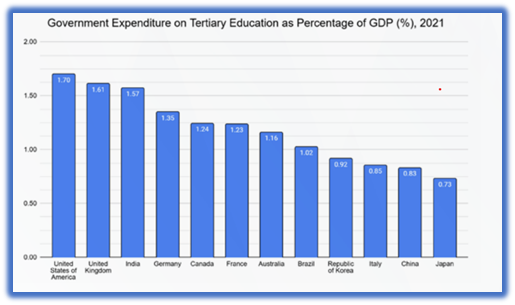
Conclusion
India’s higher education sector has seen impressive growth, with significant increases in enrollment, expanded State Public Universities (SPUs), and improved representation of disadvantaged groups. The country has made strides in gender parity, faculty development, and global research contributions. With the National Education Policy (NEP) 2020, India aims for a GER of 50% by 2035, focusing on further strengthening education infrastructure, faculty, and research to ensure equitable access to quality education.
Reference
https://static.pib.gov.in/WriteReadData/specificdocs/documents/2024/jun/doc202467340601.pdf
https://x.com/narendramodi/status/1806249732043628945
https://www.niti.gov.in/sites/default/files/2025-02/Expanding-Quality-Higher-Education-through-SPUs.pdf
Kindly find the pdf file
****
Santosh Kumar/ Sarla Meena/ Kamna Lakaria
(रिलीज़ आईडी: 2102789)
आगंतुक पटल : 3990